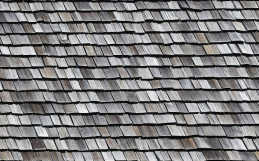When it comes to how often you should reshingle your roof, there is no hard and fast rule. Depending on the type of material used for your shingles, how well they have been maintained, and how old your roof is, you may need to replace shingles anywhere from every 15 years to up to 30 years.
The main reason homeowners decide to replace their shingles is due to age or damage. Over time, exposure to sunlight and other elements can cause composite asphalt shingles to wear down or become brittle – increasing the risk of leaks and water damage. High winds have been known to blow shingles completely off the roof!
If you find that some of your shingles are missing or damaged, it’s important that you act quickly in order to prevent further damage. Even the smallest leaks can cause significant damage if unnoticed or left unaddressed. Water can discolor your ceiling and walls, cause harmful mildew and black mold, and even rot the structure itself.
How often should you reshingle your roof?
As we said, there are a lot of factors at play when it comes to reshingling your roof. All things being equal, however, it comes down to what kind of roofing materials you use. Composite or architectural asphalt shingle roofs last between years, cedar shake shingles last around 20 years or more, and metal roofing and slate shingles can last up to 100 years!
If you decide to reshingle your roof yourself, make sure you understand how the process works for each kind of material. Composite shingles are easier to work with, weigh way less than slate, and are straightforward to install. Cedar shingles have their own installation methods, and slate roofing installation is different still.
How to reshingle a composite asphalt roof
Time to replace your roof shingles? First, remove all existing shingles from the roof, being careful not to damage any of the underlayment roof material. Once the shingles are off, you should look for signs of damage to the underlayment and decking to make sure there isn’t any damage. You don’t want to just cover up issues that will lead to roof failure in the future.
There are tools made specifically for this job: A roofing shovel is designed to get under the shingles and pull up the nails, pry bars, roofing or utility knife, and more. Depending on the slope of your roof, you may want to consider a harness as well. We can’t stress this enough–Safety First!
We also recommend–if you’re doing this yourself–to have a dump box handy for all of the debris that comes with a roof tear-off. Take breaks to clean up all of the old shingles: Taking a few minutes to remove the spent shingles makes the job site safer and helps protect the landscaping below.
Reshingle Your Roof
Starting from the bottom of the roof, nail shingles into place following the manufacturer’s guidelines. As you approach breaks in the roof (chimney, skylights, walls, etc.), inspect the flashing. If damaged, make sure to replace it. This will help channel water away from the roof.
You’ll finish with ridge caps, cut off any overhanging shingles, repair any damage to the gutter system, and you’re done! Ultimately, how often you should reshingle your roof depends on the age of the shingles and how well they have been maintained over time.
While asphalt shingles may need to be replaced sooner than others, it is still important to inspect your roof regularly to look for warning signs that your roof needs to be replaced. If you’re able to spend entire days working on your roof, you should be able to reshingle it over a long weekend.
Work with Experienced Roofing Contractors
However, if you’re not a “DIY’er,” reshingling a roof can be a daunting task, especially if the weather is less than ideal. For three decades, Warner Roofing and Construction have been replacing all manners of roofing materials once they’ve reached the end of their lifespan. We work efficiently, safely, and cleanly during all seasons to keep your home protected from the elements.
By understanding how often you should reshingle your roof, and what material is best for your needs, you can keep your home safe from water damage and other issues. With proper maintenance and care (such as removing moss growth when you see it), your new roof can last for many years to come.







